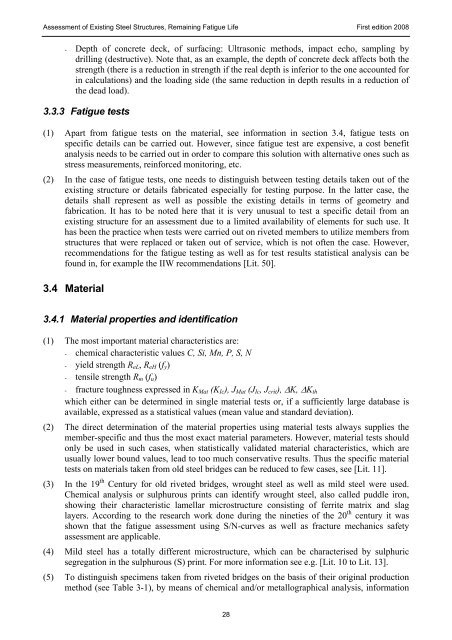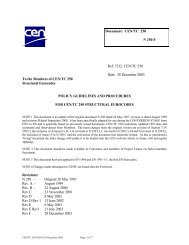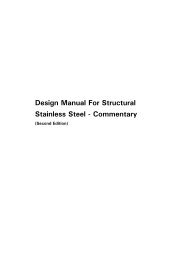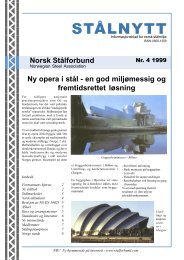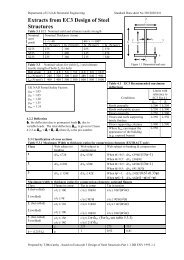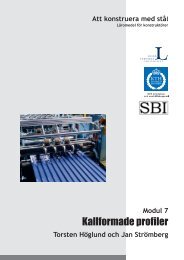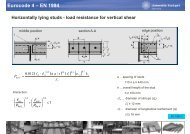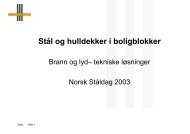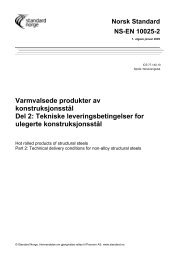Assessment of Existing Steel Structures: Recommendations for ...
Assessment of Existing Steel Structures: Recommendations for ...
Assessment of Existing Steel Structures: Recommendations for ...
- No tags were found...
Create successful ePaper yourself
Turn your PDF publications into a flip-book with our unique Google optimized e-Paper software.
<strong>Assessment</strong> <strong>of</strong> <strong>Existing</strong> <strong>Steel</strong> <strong>Structures</strong>, Remaining Fatigue Life First edition 2008- Depth <strong>of</strong> concrete deck, <strong>of</strong> surfacing: Ultrasonic methods, impact echo, sampling bydrilling (destructive). Note that, as an example, the depth <strong>of</strong> concrete deck affects both thestrength (there is a reduction in strength if the real depth is inferior to the one accounted <strong>for</strong>in calculations) and the loading side (the same reduction in depth results in a reduction <strong>of</strong>the dead load).3.3.3 Fatigue tests(1) Apart from fatigue tests on the material, see in<strong>for</strong>mation in section 3.4, fatigue tests onspecific details can be carried out. However, since fatigue test are expensive, a cost benefitanalysis needs to be carried out in order to compare this solution with alternative ones such asstress measurements, rein<strong>for</strong>ced monitoring, etc.(2) In the case <strong>of</strong> fatigue tests, one needs to distinguish between testing details taken out <strong>of</strong> theexisting structure or details fabricated especially <strong>for</strong> testing purpose. In the latter case, thedetails shall represent as well as possible the existing details in terms <strong>of</strong> geometry andfabrication. It has to be noted here that it is very unusual to test a specific detail from anexisting structure <strong>for</strong> an assessment due to a limited availability <strong>of</strong> elements <strong>for</strong> such use. Ithas been the practice when tests were carried out on riveted members to utilize members fromstructures that were replaced or taken out <strong>of</strong> service, which is not <strong>of</strong>ten the case. However,recommendations <strong>for</strong> the fatigue testing as well as <strong>for</strong> test results statistical analysis can befound in, <strong>for</strong> example the IIW recommendations [Lit. 50].3.4 Material3.4.1 Material properties and identification(1) The most important material characteristics are:- chemical characteristic values C, Si, Mn, P, S, N- yield strength R eL , R eH (f y )- tensile strength R m (f u )- fracture toughness expressed in K Mat (K Ic ), J Mat (J Ic , J crit ), ΔK, ΔK thwhich either can be determined in single material tests or, if a sufficiently large database isavailable, expressed as a statistical values (mean value and standard deviation).(2) The direct determination <strong>of</strong> the material properties using material tests always supplies themember-specific and thus the most exact material parameters. However, material tests shouldonly be used in such cases, when statistically validated material characteristics, which areusually lower bound values, lead to too much conservative results. Thus the specific materialtests on materials taken from old steel bridges can be reduced to few cases, see [Lit. 11].(3) In the 19 th Century <strong>for</strong> old riveted bridges, wrought steel as well as mild steel were used.Chemical analysis or sulphurous prints can identify wrought steel, also called puddle iron,showing their characteristic lamellar microstructure consisting <strong>of</strong> ferrite matrix and slaglayers. According to the research work done during the nineties <strong>of</strong> the 20 th century it wasshown that the fatigue assessment using S/N-curves as well as fracture mechanics safetyassessment are applicable.(4) Mild steel has a totally different microstructure, which can be characterised by sulphuricsegregation in the sulphurous (S) print. For more in<strong>for</strong>mation see e.g. [Lit. 10 to Lit. 13].(5) To distinguish specimens taken from riveted bridges on the basis <strong>of</strong> their original productionmethod (see Table 3-1), by means <strong>of</strong> chemical and/or metallographical analysis, in<strong>for</strong>mation28


